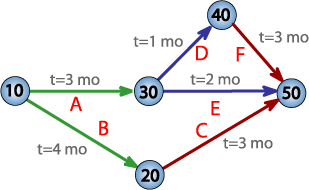I've had a subscription to a trade rag called CrossTalk (The Journal of Defense Software Engineering) for a few years now. I've read the articles but none really got my attention and kept it. In the December 2008 issue, there is an article about comparing Earned Value Management Methods to Earned Schedule. It was written by Walt Lipke of the Oklahoma City Chapter of PMI. Now that I'm working on a very large government project, this article really sparked my interest. If you're working in a government PMO or on a government project, I recommend you give it a read. The author did a really good job of using real project data and also did an excellent job comparing EVM methods to the Earned Schedule (ES) prediction technique.
If you're new to Earned Value Management or still studying for your PMP, this may make your head hurt a little. If PVcum, EVcum, and BAC are in your daily vocabulary, you'll enjoy it. Article Link

 Critical Path Method includes determining the longest path in a network diagram and the earliest and latest an activity can start and the earliest and the latest that activity can be completed. Here are a few basic things you need to think about.
Critical Path Method includes determining the longest path in a network diagram and the earliest and latest an activity can start and the earliest and the latest that activity can be completed. Here are a few basic things you need to think about.